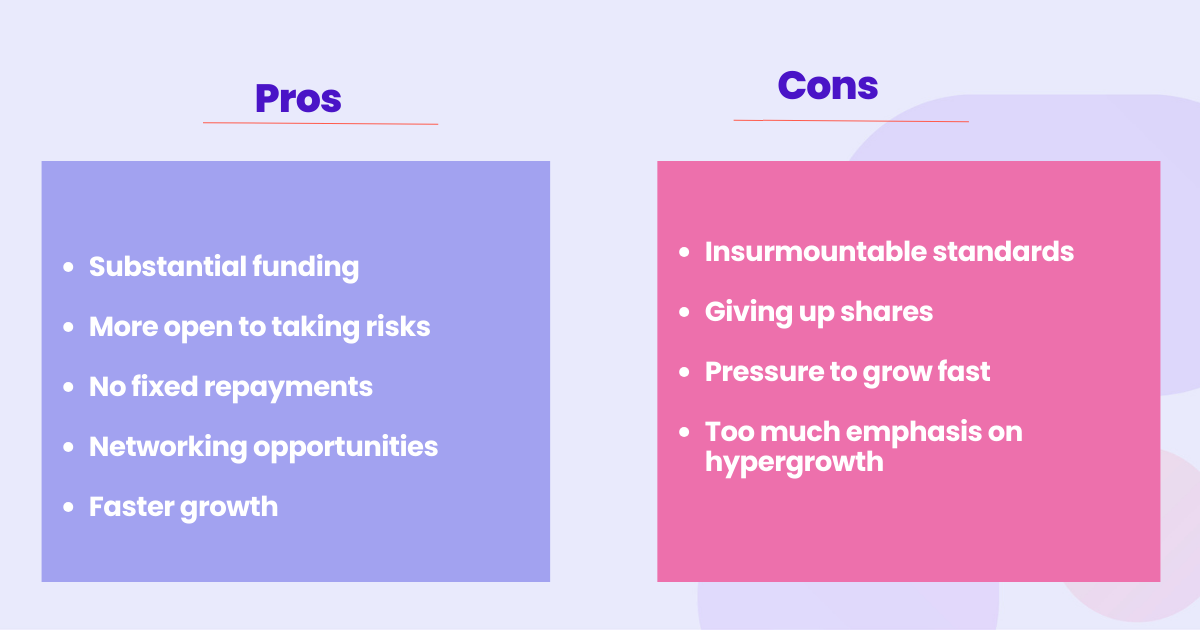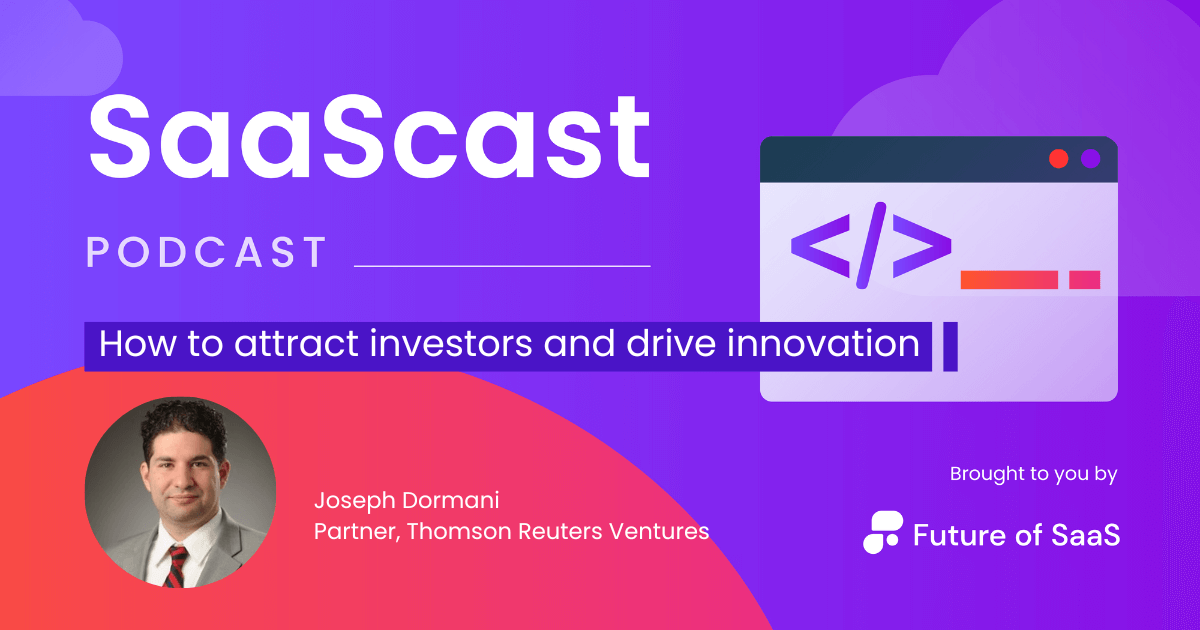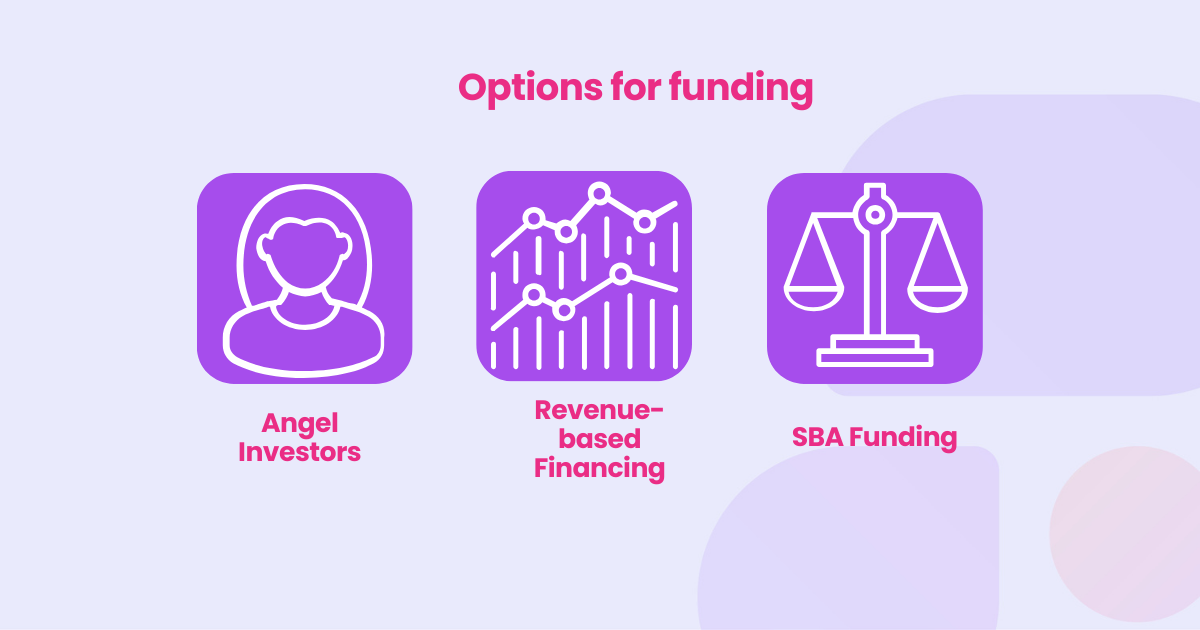Many SaaS founders have great ideas, but sadly, due to lack of financial backing, those ideas too often wither on the vine. In 2024, as a result of a volatile economic climate, this is more difficult than ever, as venture capitalists are more reluctant than ever to take that chance on a new startup.
There are certainly other options, such as bootstrapping and relying on your own savings, but the reality is most people don’t have this luxury, and so investor funding is still the most desirable option. But even if you’re able to secure funding, there can be drawbacks as well as advantages. We break them down here.
What is venture capital funding?
In a nutshell, venture capital funding is when VC firms or finance companies are impressed enough by a new startup to have confidence in its chances of becoming lucrative, and so they invest capital into the organization in exchange for shares.
But Investors don’t give out funds like candy, they need to be convinced that the startup as high growth potential so they get a return on their investment.
But given that 90% of startups fail, sadly the odds are not in your favor for securing investment. As a result startups have to be scrupulous in their investment pitches, wowing competitors with trailblazing ideas and outlining a realistic business plan that accounts for risk and market conditions.
Because of these stats, VCs will typically want a hand in the direction your company is headed, so that they can protect their investment.
Pros and cons of venture capital investment
If you’re a bit strapped for time, we’ve put them together in the form of an infographic.

Now let’s break it down in more detail
Advantages of venture capital funding
1. Substantial funding
Let's talk about one of the most exciting perks of venture capitalist funding: the injection of funds it provides.
Venture capital firms pool resources from various sources, often LPs, to provide startups with substantial cash injections. You can gain considerably larger funding from VC funding than you run of the mill small business loan, and you don’t have to repay venture capital in periodic installment like you would with loans. Plus, there's potential for multiple rounds of funding.
In simple terms, VC funding can give orgs the potential for rapid, broad expansion, reaching an audience that might not have been able to touch otherwise.
2. Venture capitalists are more likely to take risks
Conventional banks are known for their cautious approach, often avoiding lending to startups they deem too risky. On the other hand, venture capitalists thrive on risk, particularly when it comes to supporting early-stage ventures.
So, if you're sitting on a potential goldmine but finding traditional funding avenues closed off, teaming up with a VC could be a game-changer.
But it's not all smooth sailing. While VCs may be more inclined to take risks, they're not doing it out of the kindness of their hearts (although many VCs are genuinely passionate about seeing startups succeed). They're in it for the big returns, aiming for profits of 25-35% or more to justify their investment and meet their fund's objectives. So, before you take the plunge, ensure your business plan is solid and shows promising commercial viability.

Now, picture this scenario: lightning strikes, and a VC decides to back your vision. Suddenly, you've got the green light to push boundaries and explore new opportunities, knowing you have financial support to catch you if things get rocky.
So, if you're considering a bold idea with the potential for high rewards, VC investment could be your ticket to turning it into a successful venture that not only fills your pockets but also fulfills your agreement with your VC partner.
Hands on support
A plus side (and to some a downside) is that venture capital investors tend to want a hand in the direction your company goes in. That might sound potentially overbearing, but the reality is that you’ll be benefitting from expertise straight from the minds of experienced entrepreneurs.
Not only do you get the benefit of expertise, but you also potentially have access to a broad network of experts, increasing your chances of potential growth.
No repayments
Well, you are paying them back, but it’s not like other kinds of loans where you’ll be expected to pay back in installments on certain dates. Instead VC firms have shares in your company which increase in value as the company becomes more profitable.
This takes some of the pressure off you as a founder; you won’t have to worry about having the requisite cash flow to pay off loans every month. However, shareholders will want to be kept in the loop with regards to the steps your company is taking to achieving growth.
Networking opportunities
Investors are always looking for new opportunities, and the way they do this is by constantly expanding their network. So when you have a venture capitalist on the board, you’re not just getting their expertise which will likely be considerable on its own) you’re also potentially benefiting from a global network of entrepreneurial experts.
Networking is an essential component of how SaaS startups expand, and the nifty thing about it is: The more you do it the easier it gets.

Faster growth
What venture capitalists can offer are large amounts of capital in contrast to what traditional banks can offer, which means potentially faster growth for your startup. In a fast paced, highly competitive SaaS landscape, scaling fast is going to put you at a considerable advantage, however, it’s important to note that investors will want to see that you can grow sustainably over this time period.
Now, the two often go hand in hand obviously, but there can be instances where companies are experiencing a period of hyper growth, but the organization is rapidly descending into chaos. The obvious result of this: Growth won’t last over a prolonged period of time. There are always startups that come flying out of the gate, but many of them don’t become household names.
The disadvantages of venture capitalist funding
Now even with the considerable advantages of venture capital funding, there can be downsides. Those who don’t fancy surrendering some of the control to investors, for example, might want to consider other options. But there are other downsides too, let’s dive into it here.
Insurmountable standards
It's important to understand just how challenging it can be to get the green light from VCs. It's easily one of the toughest hurdles you'll face when trying to raise funds.
The whole process can feel like a never-ending saga, often stretching out for months – sometimes even over 9 months! Why so long? Well, VC firms take their time to meticulously evaluate your business. After all, they're not just throwing money around; they want to ensure they're making a wise investment that will yield significant returns for their investors.

So, what exactly are they looking for? They'll dig deep into every aspect of your business, from the size of your target market to the potential profitability of your products or services. They'll assess the strength of your management team and weigh the potential rewards against the risks.
You'll need to lay out your business plan and financial projections, clearly demonstrating the value and growth potential of your venture.
Hyper growth over sustainable growth
For many SaaS startups, landing that sweet VC investment feels like the ultimate win. But here's the thing: plenty of early-stage companies have thrived simply by delivering a killer product and letting word-of-mouth do the rest. In today's fierce market, SaaS firms need to be smart about how they grow – and that often means getting savvy with organic social channels.
Some startups get so caught up in throwing money at growth that they lose sight of what really matters. They end up chasing quick wins instead of focusing on building sustainable, long-term success.
Instead, it's all about finding that balance – prioritizing steady, scalable growth over flashy but short-lived spikes. By keeping their eyes on the prize, startups can set themselves up for lasting success in SaaS.
Giving up shares
One of the most daunting disadvantages for startup founders is this: once investors have shares of your company many are going to want to have a say in your business. And that’s not all, as your company grows, you may outgrow that initial funding and require subsequent rounds of funding, but that means giving away more equity in your company.
This isn’t true for all venture capitalist investors, some of whom will take a more hands off approach, but VCs have been known to want up to 80% of startup businesses.
Pressure to grow too fast
Given the stats on startup success aren’t exactly glowing, it’s easy to come to the conclusion that VCs are taking a pretty serious risk in investing, and as a result there’s going to be a lot of pressure for you to scale fast.
While healthy pressure can be a good thing, it can sometimes lead to some drastic and even reckless decision-making at odds with the kind of careful planning that needs to go into launching a startup to success. Companies may have very specific ideas about the kind of customers you should be targeting, which could lead to you being overwhelmed with the number of customers you have to service.
Other options apart from venture capital funding
Luckily bootstrapping and private savings are not your only option when it comes to funding your business. Here are some others you might want to consider

Angel investors
These are simply individuals who will invest in companies. In some cases, they will be friends or family, so this often comes with less pressure for early stage companies, but they will still expect a return on investment.
They tend to be more open to investing in startups, since they look for companies that have potential and are less thorough in their assessment of a company before investing. It’s a more easy-going, unstructured approach and it’s often a one-off payment, although they will sometimes offer additional funding in later stages of development.
Revenue-based financing
Instead of the traditional model where you're pressured with fixed payments, revenue-based financing lets investors take a regular cut of your business earnings until they've made back about three to five times what they initially put in. And the best part? No interest fees to worry about.
What makes it even sweeter is that your repayments are tied directly to how well your business is doing. So, as your business grows, so do your payments back to the investor.

SBA loans
SBA loans are like having a financial safety net, backed in part by the government to ease the nerves of lending institutions. Here's the deal: while the SBA doesn't directly hand out cash, it teams up with approved financial players like banks to get small businesses the funding they need.
Sure, there are monthly repayments involved, but with the SBA's partial guarantees, lenders breathe a bit easier knowing that if things go south the state covers a chunk of the loan.
Now, why should you care? Well, SBA loans offer an enticing alternative to chasing venture capital. Think competitive interest rates, repayment terms stretching around a decade, and best of all – you get to hold onto your equity. As long as you've got the cash flow to keep up with repayments, an SBA loan could be whatyour business needs.
Wrapping up
In the competitive world of SaaS startups, having a great idea isn't always enough. Many promising concepts fade into obscurity due to a lack of financial backing, a challenge exacerbated by the uncertainties of today's economic climate.
In 2024, with venture capitalists more cautious than ever, securing investment can feel like an uphill battle. While alternative funding options exist, such as bootstrapping and personal savings, they're not always accessible to everyone. Investor funding remains the most desirable route for many, offering the potential for substantial growth and expansion, but it's a difficult road to travel, so consider other options beforw committing to pursuing VCs.
Like what you see? Why not check out exclusive insights from the leading minds in SaaS?



